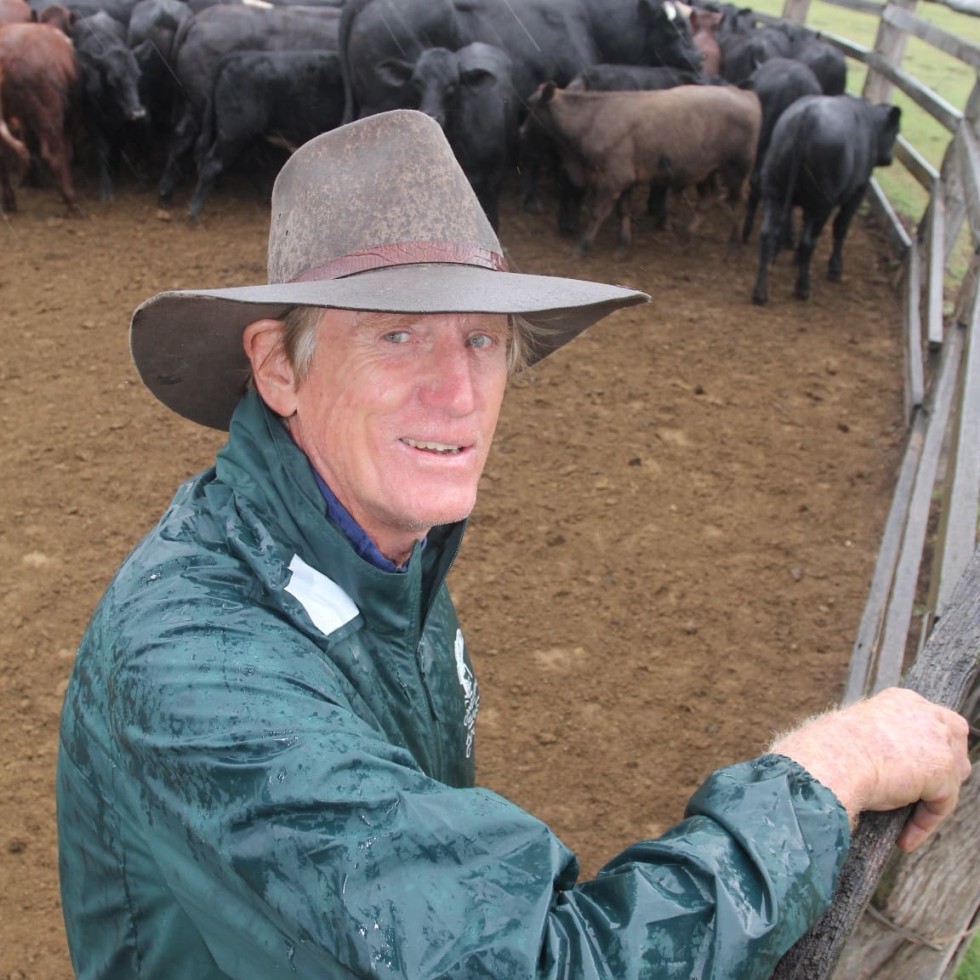 What are the contributing factors behind extreme feedlot cattle performance?
What are the contributing factors behind extreme feedlot cattle performance?
This morning Beef Central continues the second half of yesterday’s report on a record-setting pen of 168 Shorthorn x Angus and Angus 100-day steers fed recently at Grassdale feedlot near Dalby, which closed-out last week having produced an average daily gain of 2.74kg.
The steers produced an as-fed net feed conversion of 6.48:1, averaged 17.76kg/day consumption, and produced a cost of gain figure of just $1.68/kg, based on a ration price of $260/t (price locked in before prices kicked). Readers can access yesterday’s original report "Grassdale's record-breakers bend the ADG curve" here.
That performance produced a turnaround in value worth $108 ahead over Beef Central’s ‘benchmark’ 100 day steer used in fortnightly trading budget calculations.
Today’s report focusses on comments from western Darling Downs cattleman Lee McNicholl, who bred and grew-out the steers before consigning them to Grassdale feedlot for custom-feeding; and Mort & Co’s consultant feedlot nutritionist Matt George.
Dr George, from Bovine Dynamics, said since the end of July, the feedlot industry had largely enjoyed dry pens and cattle comfort had been ‘outstanding.’
“With increased daylight hours, we always seasonally see good performances at this time of year, but certainly the result seen in the McNicholl cattle is up there with the top one percent of cattle we would see on an annual basis,” he said.
Another point worth noting this year was that after two or three consecutive well above average seasons across most of eastern Australia, there had been little or no compensatory gain evident in feedlot cattle, which would otherwise distort such results.
Dr George suggested the performance produced by the cattle could be put down to a number of factors.
“We’ve had a series of good seasons, and hence feeder cattle, immunologically, are sound, and they’ve had good early growth, due to the seasons, without being excessively forward,” he said.
“On top of that, credit must go to the Grassdale feedlot team, they are just doing the little things very, very well, in terms of being able to extract that genetic potential.”
Other factors Dr George offered as contributors to the process included:
- the fact that the McNicholl cattle were direct-consigned and fed as a mob, rather than sharing a feeding pen with cattle from other suppliers, which always enhances risk of respiratory problems through co-mingling; and
- the use of quality genetics, and application of sound weaning and herd management – not surprising, given that the vendor was a veterinarian by training. Being good, well-selected British cattle that were well-adapted to southeast Queensland feeding conditions was also reflected in pen health, where the cost per beast (just eight treatments recorded), was just $1.47. That compared with an average annual treatment cost on similar cattle around $6.50-$7, Dr George said.
“It’s an accumulation of a whole lot of factors that have obviously contributed to a result like this,” he said.
“Granted, all yards across southern Queensland have performed extremely well this spring, feeding results wise – but that does not diminish the performance of this particular group of cattle. They are right out there, in terms of the standard deviations we would expect to see on the bell-curve.”
Dr George said some of the new vaccine technologies coming through the pipeline would help lift overall feedlot performance in the near future.
This included Coopers’ new Bovilis MH + IBR vaccine, and a new single-shot Pfizer BRD product expected to hit the market about March next year. Multi-treatment vaccines had been one of the big stumbling blocks for greater vaccine uptake prior to feedlot entry up to now.
One of the real challenges in terms of progressing pre-feedlot entry vaccination programs over the past few years has been caused by the big grass-growing seasons experienced, Dr George said.
“Producers generally haven’t had the inclination to direct cattle into feedlots, give the grass they have at their disposal, and as a result preventative pre-entry programs like FeederGuard and MaxiStart have unfortunately struggled,” he said.
“It would be great to again get some greater awareness of the benefits of pre-vaccination. As things dry out, feedlots will again see greater dust loads, and nutrition on those cattle diminishes a little, over time. That all becomes incrementally more important, and new vaccines will help manage that risk,” he said.
 Dulacca cattleman Lee McNicholl, who bred the recent Grassdale record-setters and retained ownership under a Mort & Co Private Client custom-feeding program, provided some useful background details to help explain their high performance.
Dulacca cattleman Lee McNicholl, who bred the recent Grassdale record-setters and retained ownership under a Mort & Co Private Client custom-feeding program, provided some useful background details to help explain their high performance.
The steers, around 24 months of age at slaughter, were roughly split between Shorthorn x Angus F1s, and straightbred Angus. The McNicholl family grazing business uses Shorthorn bulls from Arubial and Woolcott Shorthorns, and Angus from Raff Angus and Glenoch (Boshammers).
Among the F1 component, ABRI geneticist Hans Glasser suggested there could be 7-8pc hybrid vigour gain with Angus x Shorthorn steers. That would be worth 0.22kg/day gain alone, in the mob’s overall ADG of 2.74kg, Mr McNicholl said.
Supporting comments about ‘framiness and capacity to grow’’ made yesterday by Grassdale’s Ben Maher, Mr McNicholl said he puts bull selection pressure on 600-day growth and eye muscle area, as well as marbling.
“I try to aim for bulls in the top 30pc of the breed for desirable traits, with emphasis on growth and retail beef yield (de facto measures like EMA and fat cover),” he said.
While large-framed breeds like Charolais and Santa Gertrudis are more commonly associated with high growth rate in feedlots, Mr McNicholl said there was no shortage of Angus cattle out there now with real frame and growth potential. “In the US, there’s been talk about using Angus as terminal sires, such as been the selection pressure on mature cow size,” he said.
The steers had had a ‘good run’ season-wise as calves, and were yards-weaned on good hay for a week or more, while being worked through the yards. They came into another good summer in 2012, spending the early stages of this year in a buffel paddock with some herbage present over winter, before tailing-off as the winter progressed.
“They weren’t fat, but went into the feedlot in store to forward store condition, averaging around 377kg, but ranged from 310kg to 450kg,” Mr McNicholl said.
The original intention was to feed the lighter end to Woolworths specs, but because of their truly prodigious growth of 2.74kg/day and continued growth curve right through the program, all easily made 100-day export weights, and all graded MSA.
The steers received a 100-day Revalor Flex oestradiol/TBA combo grass implant at weaning, followed by a Component 100-day implant at feedlot induction.
An early indicator of their likely performance came in August when seven steer cohorts from the same calf-drop, selected on weight, won Brisbane Show’s 100-day grainfed performance class for the McNicholls, from about 40 entries representing a vast spectrum of breed types. Those seven competition steers closing-out back in early August produced an ADG of 2.57kg/day, and an average marbling score of 2.1.
While the record-setting steers killed last week received no pre-entry BRD vaccination, Mr McNicholl plans to make it a permanent part of his husbandry practice from next year.
“We were perhaps a little lucky with these cattle, but it does not take that much of a respiratory setback in the feedlot to justify the cost of vaccination,” he said.
“Because we normally take a whole pen at the feedlot for our cattle, avoiding co-mingling, and they are not stressed going in, travelling only an hour or two, we have rarely had any real BRD problems. But as added insurance, we think it is worthwhile to prevent production setback in future.”
While the McNicholls have typically only retained ownership and custom-fed a portion of their annual steer turnoff in recent years, the decision was made to feed this particular mob because they ‘didn’t like the store price at the time,’ and had the high performance signals from the Brisbane Show-winning cohort steers to encourage them to hold onto them, ownership-wise.
“If you have well-bred, well managed cattle, unless you retain ownership in the feedlot, you don’t get their full value,” he said.
- Readers should not there was a minor adjustment to yesterday’s story, referencing ration composition used at Grassdale. The sentence should have read 71pc dry matter, not 74pc protein, as originally published. No ration protein content figures were available from Grassdale.
